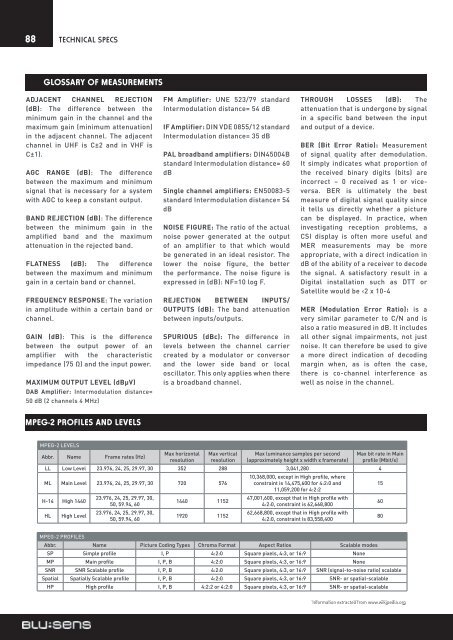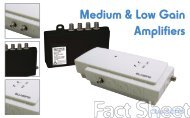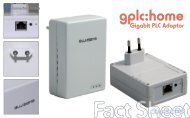IPTV - Blusensnetworks
IPTV - Blusensnetworks
IPTV - Blusensnetworks
- No tags were found...
Create successful ePaper yourself
Turn your PDF publications into a flip-book with our unique Google optimized e-Paper software.
88Technical Specs Technical Specs 89Glossary of MeasurementsADJACENT CHANNEL REJECTION(dB): The difference between theminimum gain in the channel and themaximum gain (minimum attenuation)in the adjacent channel. The adjacentchannel in UHF is C±2 and in VHF isC±1).AGC RANGE (dB): The differencebetween the maximum and minimumsignal that is necessary for a systemwith AGC to keep a constant output.BAND REJECTION (dB): The differencebetween the minimum gain in theamplified band and the maximumattenuation in the rejected band.FLATNESS (dB): The differencebetween the maximum and minimumgain in a certain band or channel.FREQUENCY RESPONSE: The variationin amplitude within a certain band orchannel.GAIN (dB): This is the differencebetween the output power of anamplifier with the characteristicimpedance (75 Ω) and the input power.MAXIMUM OUTPUT LEVEL (dBμV)DAB Amplifier: Intermodulation distance=50 dB (2 channels 4 MHz)MPEG-2 Profiles and LevelsMPEG-2 LEVELSAbbr. Name Frame rates (Hz)FM Amplifier: UNE 523/79 standardIntermodulation distance= 54 dBIF Amplifier: DIN VDE 0855/12 standardIntermodulation distance= 35 dBPAL broadband amplifiers: DIN45004Bstandard Intermodulation distance= 60dBSingle channel amplifiers: EN50083-5standard Intermodulation distance= 54dBNOISE FIGURE: The ratio of the actualnoise power generated at the outputof an amplifier to that which wouldbe generated in an ideal resistor. Thelower the noise figure, the betterthe performance. The noise figure isexpressed in (dB): NF=10 log F.REJECTION BETWEEN INPUTS/OUTPUTS (dB): The band attenuationbetween inputs/outputs.SPURIOUS (dBc): The difference inlevels between the channel carriercreated by a modulator or conversorand the lower side band or localoscillator. This only applies when thereis a broadband channel.Max horizontalresolutionMax verticalresolutionMax luminance samples per second(approximately height x width x framerate)THROUGH LOSSES (dB): Theattenuation that is undergone by signalin a specific band between the inputand output of a device.BER (Bit Error Ratio): Measurementof signal quality after demodulation.It simply indicates what proportion ofthe received binary digits (bits) areincorrect – 0 received as 1 or viceversa.BER is ultimately the bestmeasure of digital signal quality sinceit tells us directly whether a picturecan be displayed. In practice, wheninvestigating reception problems, aCSI display is often more useful andMER measurements may be moreappropriate, with a direct indication indB of the ability of a receiver to decodethe signal. A satisfactory result in aDigital installation such as DTT orSatellite would be










